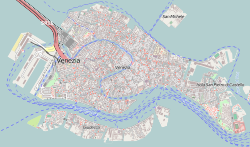| Church of San Beneto | |
|---|---|
 | |
| Religion | |
| Affiliation | Roman Catholic |
| Location | |
| Municipality | Venice |
| Country | Italy |
| Coordinates | 45°26′08″N12°19′57″E / 45.435626°N 12.332386°E |
| Architecture | |
| Type | Church |
| Style | Baroque |
| Completed | 1685 |
The Chiesa di San Benedetto (Church of Saint Benedict) is a Roman Catholic church in Venice, northern Italy. Generally known as San Beneto in the Venetian dialect, the church faces the square named after it, the Campo San Beneto. It was founded in the 11th century and rebuilt in 1685.
San Beneto is a vicariale (subsidiary) church of the parish of San Luca. [1]

